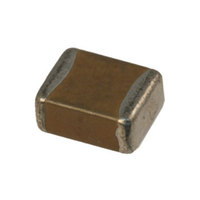1210AC103KAT1A AVX Corporation, 1210AC103KAT1A Datasheet - Page 11

1210AC103KAT1A
Manufacturer Part Number
1210AC103KAT1A
Description
CAP CERM 10000PF 1000V X7R 1210
Manufacturer
AVX Corporation
Series
1210r
Specifications of 1210AC103KAT1A
Capacitance
10000pF
Tolerance
±10%
Package / Case
1210 (3225 Metric)
Voltage - Rated
1000V (1kV)
Temperature Coefficient
X7R
Mounting Type
Surface Mount, MLCC
Operating Temperature
-55°C ~ 125°C
Features
High Voltage
Applications
General Purpose
Size / Dimension
0.126" L x 0.098" W (3.20mm x 2.50mm)
Thickness
1.70mm Max
Voltage Rating
1 KVolts
Operating Temperature Range
- 55 C to + 125 C
Temperature Coefficient / Code
X7R
Product
High Voltage MLCCs
Dimensions
0.098 in W x 0.126 in L x 0.067 in H
Dissipation Factor Df
2.5
Termination Style
SMD/SMT
Dielectric Characteristic
X7R
Capacitance Tolerance
± 10%
Capacitor Case Style
1210
No. Of Pins
2
Capacitor Mounting
SMD
Rohs Compliant
Yes
Case Size
1210
Material, Element
Ceramic
Special Features
High Voltage
Termination
SMT
Voltage, Rating
1000 VDC
Lead Free Status / RoHS Status
Lead free / RoHS Compliant
Ratings
-
Lead Spacing
-
Lead Free Status / Rohs Status
Lead free / RoHS Compliant
Other names
478-2958-2
General Description
Table 1: EIA and MIL Temperature Stable and General
In specifying capacitance change with temperature for Class
2 materials, EIA expresses the capacitance change over an
operating temperature range by a 3 symbol code. The first
symbol represents the cold temperature end of the temper-
ature range, the second represents the upper limit of the
operating temperature range and the third symbol repre-
sents the capacitance change allowed over the
operating temperature range. Table 1 provides a detailed
explanation of the EIA system.
66
Percent Capacity Change Over Temperature Range
EXAMPLE – A capacitor is desired with the capacitance value at 25°C
to increase no more than 7.5% or decrease no more than 7.5% from
-30°C to +85°C. EIA Code will be Y5F.
Temperature characteristic is specified by combining range and
change symbols, for example BR or AW. Specification slash sheets
indicate the characteristic applicable to a given style of capacitor.
Symbol
Symbol
RS198
C
Code
A
B
W
R
S
X
Y
Z
X7
X6
X5
Y5
Z5
Application Codes
U
D
E
P
R
S
V
F
T
Cap. Change
+15%, -15%
+22%, -22%
+22%, -56%
+15%, -15%
+30%, -70%
+20%, -20%
Zero Volts
Temperature Range
MIL CODE
EIA CODE
Percent Capacity Change
-55°C to +85°C
-55°C to +125°C
-55°C to +150°C
Temperature Range
+10°C to +85°C
-55°C to +125°C
-55°C to +105°C
-55°C to +85°C
-30°C to +85°C
+22%, - 56%
+22%, -33%
+22%, -82%
±3.3%
±4.7%
±7.5%
±10%
±15%
±22%
Cap. Change
+15%, -40%
+22%, -56%
+22%, -66%
+15%, -25%
+30%, -80%
+20%, -30%
Rated Volts
Effects of Voltage – Variations in voltage have little effect
on Class 1 dielectric but does affect the capacitance and
dissipation factor of Class 2 dielectrics. The application of
DC voltage reduces both the capacitance and dissipation
factor while the application of an AC voltage within a
reasonable range tends to increase both capacitance and
dissipation factor readings. If a high enough AC voltage is
applied, eventually it will reduce capacitance just as a DC
voltage will. Figure 2 shows the effects of AC voltage.
Capacitor specifications specify the AC voltage at which to
measure (normally 0.5 or 1 VAC) and application of the
wrong voltage can cause spurious readings. Figure 3 gives
the voltage coefficient of dissipation factor for various AC
voltages at 1 kilohertz. Applications of different frequencies
will affect the percentage changes versus voltages.
Typical effect of the application of DC voltage is shown in
Figure 4. The voltage coefficient is more pronounced for
higher K dielectrics. These figures are shown for room tem-
perature conditions. The combination characteristic known
as voltage temperature limits which shows the effects of
rated voltage over the operating temperature range is
shown in Figure 5 for the military BX characteristic.
10.0
50
40
30
20
10
6.0
8.0
4.0
2.0
0
0
Curve 1 - 100 VDC Rated Capacitor
Curve 2 - 50 VDC Rated Capacitor
Curve 3 - 25 VDC Rated Capacitor
D.F. vs. A.C. Measurement Volts
Cap. Change vs. A.C. Volts
.5
AC Measurement Volts at 1.0 KHz
12.5
Volts AC at 1.0 KHz
1.0
Figure 2
Figure 3
X7R
X7R
25
1.5
2.0
37.5
2.5
Curve 3
Curve 1
Curve 2
50









